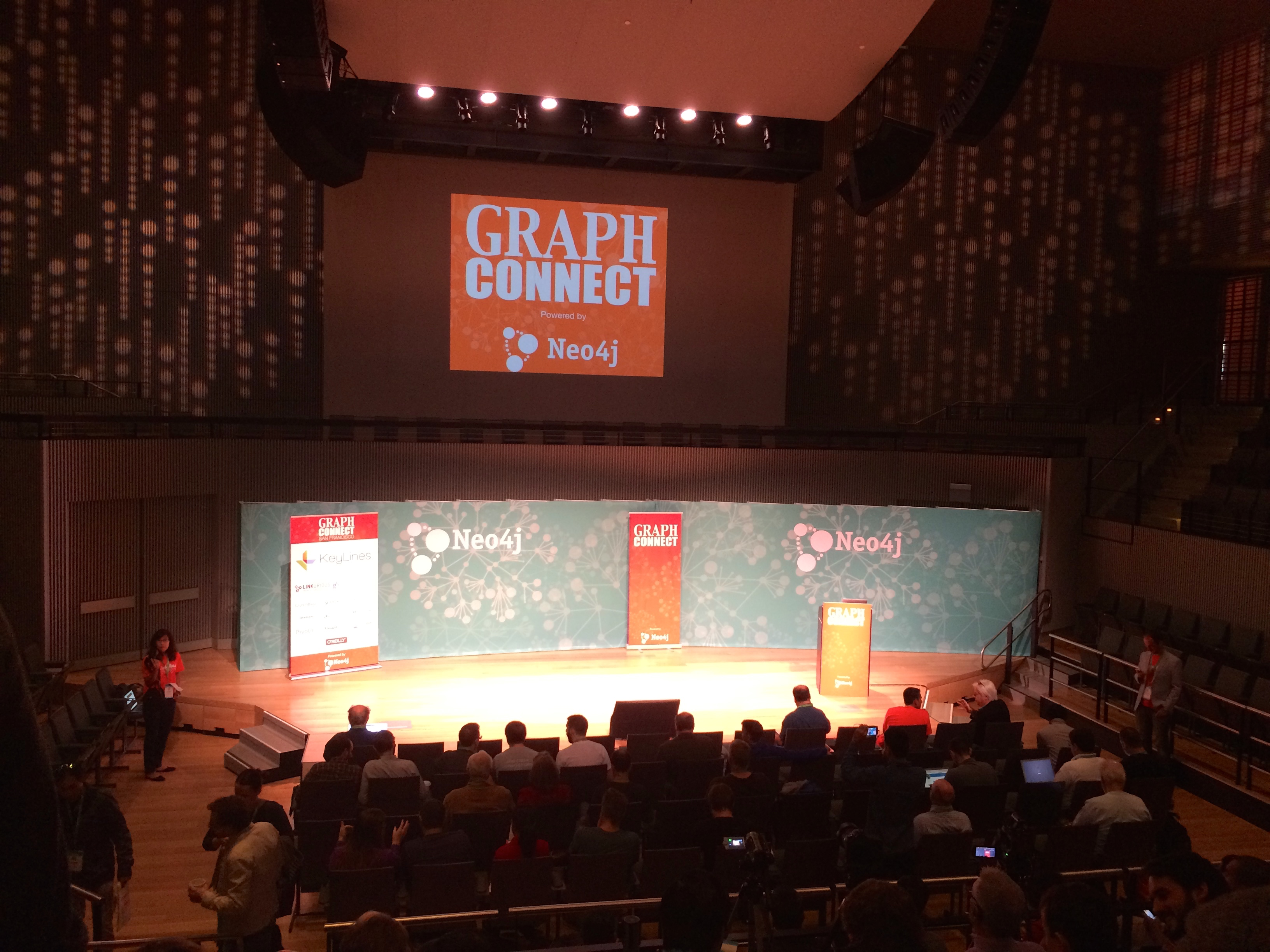
GraphConnect 2014 - San Francisco
GraphConnect is Neo Technology's annual Graph Database conference. Many of the talks highlight Neo4j use-cases, but many of the concepts are applicable to graph data modeling and graph databases in general.
Advanced Cypher training class#
The day before the conference I was able to take the Advanced Cypher training course. This course was a great in-depth dive into Cypher and I was happy that the course lived up to its name, "Advanced" Cypher. Wes Freeman did a great job leading the course. Thanks, Wes!
Graph Hack#
The evening before GraphConnect we participated in Graph Hack, a hackathon focused on building Neo4j apps using a handful of open source datasets put together by Nicole White. The datasets consisted of flight and plane data, music playlists, and public transportation data. You can find them available here if you'd like to play around with the data. My team built a simple command line app that computed the probability of your flight being delayed given the origin, destination, airline, day of flying and type of aircraft.
The following are my notes from the conference:
Keynote: Graphs Are Eating The World#
Emil Eifrem (CEO, Neo Technology)#

- The internet of connected things
- Graphs are eating the world
- Graph DBs are fastest growing NoSQL segment
- Example social query
- average 50 friends, see if two random users are connected
- 2ms Neo4j (1000 or 1000000) users
- 2s with MySQL (just 1000 friends)
- Neo4j 2.2 - performance and scale
- initial import performance - millions of inserts per second
- cypher performance improvements
- concurrent writes - ACID write to disk (currently sequential)
- batch / concurrent writes is coming in 2.2
- 100x faster for large writes
The Business Graph#
Kurt Freytag (Head of Product, CrunchBase )#
- CrunchBase started in 2007 with 2 crappy AWS servers (1 MySQL, 1 Rails)
- Power of crowd sourced data
- Evidence that people want it
- Entities, activities, connections, time
- The business lifecycle
- Graph is a natural way of modeling data
- Added Events
- announced at TCDisrupt London
- built in 2 weeks (!) because of Neo4j. This would have taken months with a RDBMS
- Graph data model adapts easily to changing requirements
- Built in Business Intelligence
- Don't know what questions to ask in advance (at data modeling time)
- OLAP alongside graph database, graphDB for ad-hoc queries
- Directly maps to Object Oriented thinking (OGM)
- Nodes = objects, etc.
- Why doesn't everybody use Neo4j?
- Historical reasons
- Databases are used as dumb data stores
- Logic / analysis is in application layer, focus on logic not data
- Not plug and play
- not supported by many high level languages
- have to think about data modeling
- CrunchBase developed Deja, a Ruby ORM for Neo4j
- Historical reasons
- Graph Insights feature on CrunchBase would not be possible without a graph database
Using Graphs for Next-Gen Master Data Management at Pitney Bowes#
Aaron Wallace (Principal Product Manager, Pitney Bowes)#
Slides: http://www.slideshare.net/neo4j/using-graphs-for-nextgen-master-data-management-at-pitney-bowes
- Integrate the data silos
- Single view of individual and connections and interactions (transactions)
- Insights / predictive analytics are now critical for companies
- Visual schema managment
- Visual query builder
- Graph database are peaking on the Gartner "Hype Cycle"
- Pull data from data silos and building the knowledge graph
- Easily expose custom built queries as a web service (REST/SOAP)
From Zero To Graph In 120: Query#
Nicole White (Data Scientist, Neo Technology)#
- Flight data set
- How to use Cypher to query this data set
- For performance, filter by cardinality first
- Example query went from 1500+ms to 198ms
From Zero To Graph In 120: Scale#
Ian Robinson (Engineer, Neo Technology)#
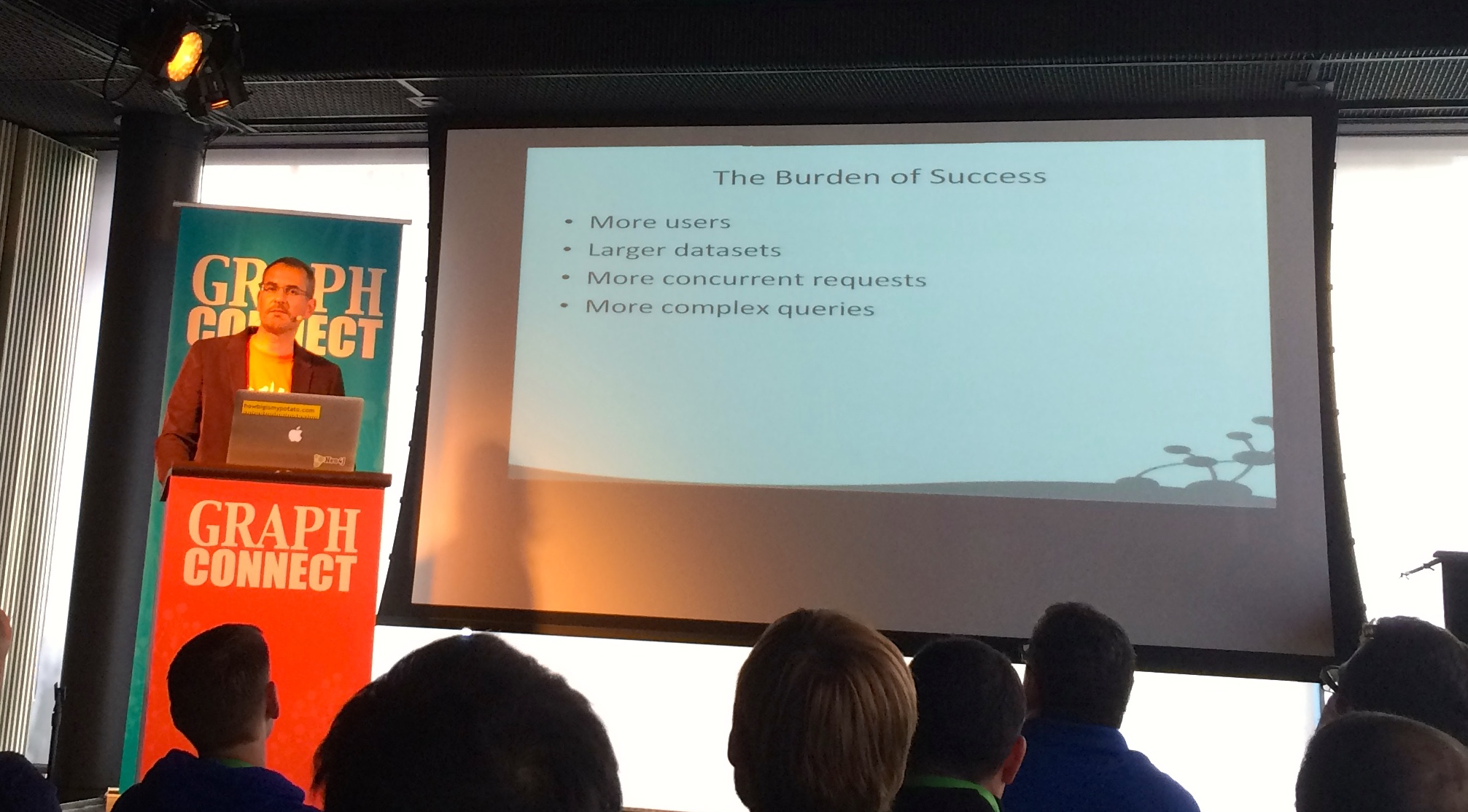
Slides: http://www.slideshare.net/neo4j/scaling-neo4jv1
- Understand current needs
- Iterative and incremental development
- Unit testing
- Performance tests
Scaling Reads - Latency#
- Latency is a function of search area
- Search area is a function of of domain invariants
- Domain invariants
- absolute - (constant query latency x=50)
- relative - x% of data set
- query latency increases as data grows
- How to reduce latency?
- Change domain invariants (often not possible)
- Improve Cypher query
- Small queries
- Separate using WITH statements
- Filter lower cardinality first
- Change model
- Explore less of the graph (reduce search area)
- Using inferred (implicit) relationships?
- replace inferred relationships with actual relationships (edges in the graph)
- Cheaper reads, but more expensive write
- More data to store
- When to update these? On insertion (same transaction)? Batch updates?
- Use unmanaged server extensions (custom API)
- Write Java code that runs in the server
- Benefits
- closer to the data
- single request, many operations
- multiple implementation options
- Cypher, Traversal API, Graph Algorithms, Java API
- control request / response format - compact, conserve bandwidth
- control HTTP header - cache control
Scaling Reads - Throughput#
- Scale horizontally - cluster
- HAProxy as read load balancer
- Object cache data is evicted
- Solved with cache sharing (consistent routing)
- Add parameter in URI for consistent routing, HAProxy config
- Solved with cache sharing (consistent routing)
Scaling Writes#
- Contention for locks
- Lock nodes at last moment
- Batch writes
- Introduce a queue layer. Can add queue inside server extension
Panel: Visualizing Graphs#
Cambridge Intelligence, Tom Sawyer Software, Linkurious and GraphAlchemist#
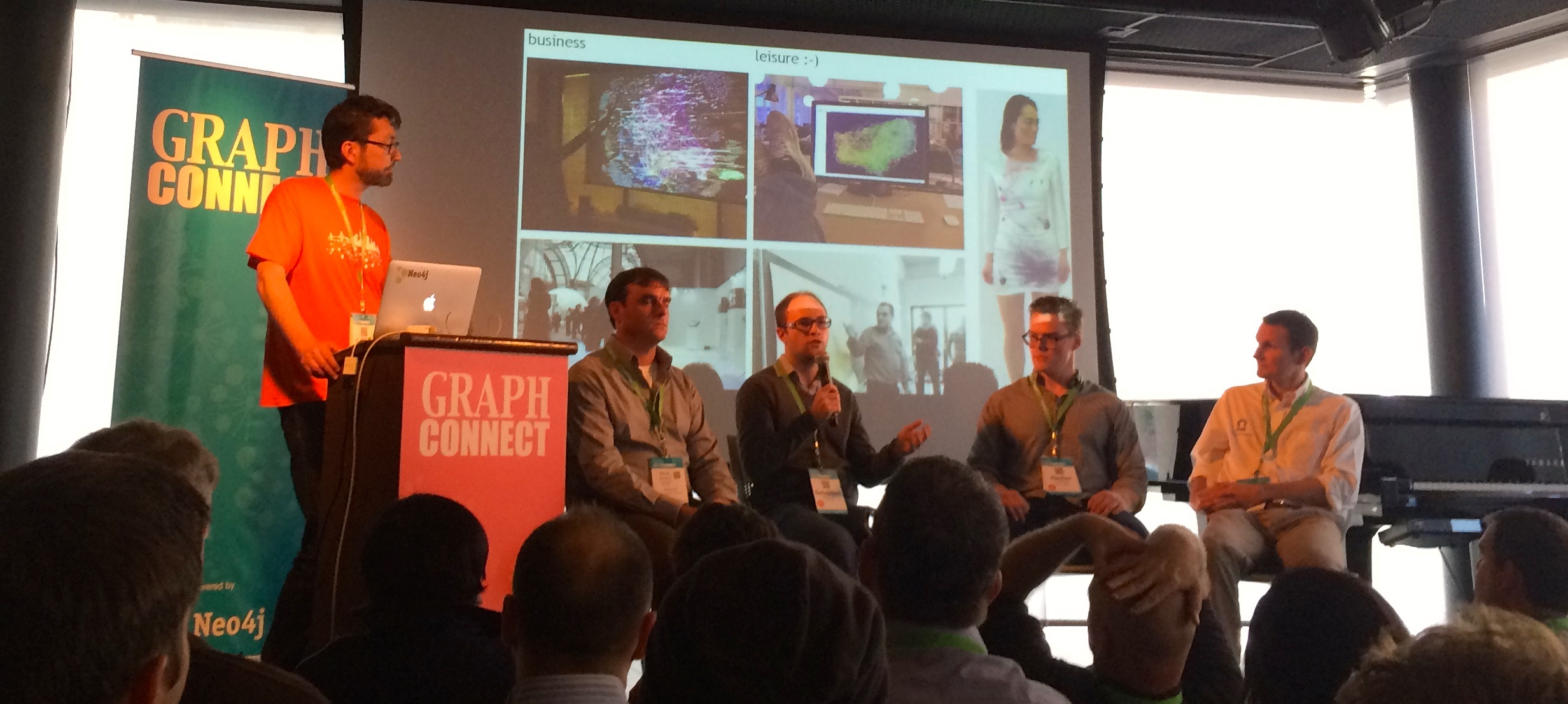
- People don't realize graphs are powering stuff (Facebook, recommendations, etc)
- Find one dimension that holds data together (ex: maps and location), but with graphs can have unlimited dimensions. Find one dimension for visualization to make sense.
- Groups / clustering. Show how groups are related, not individuals
- Trend: specific products / implementations for specific use cases
- Alternative to circles and lines?
- island approach. remove edges
- reduce number of edges for best visuals
- matrix representation
- Every aspect of the visualization can be bound to the data (color, width, etc)
- 3D visualizations?
- technology is not quite ready yet
- 2.5D shows some promise
Betting The Company On A Graph Database - Part 2#
Aseem Kishore (Developer, FiftyThree)#
Slides available here.
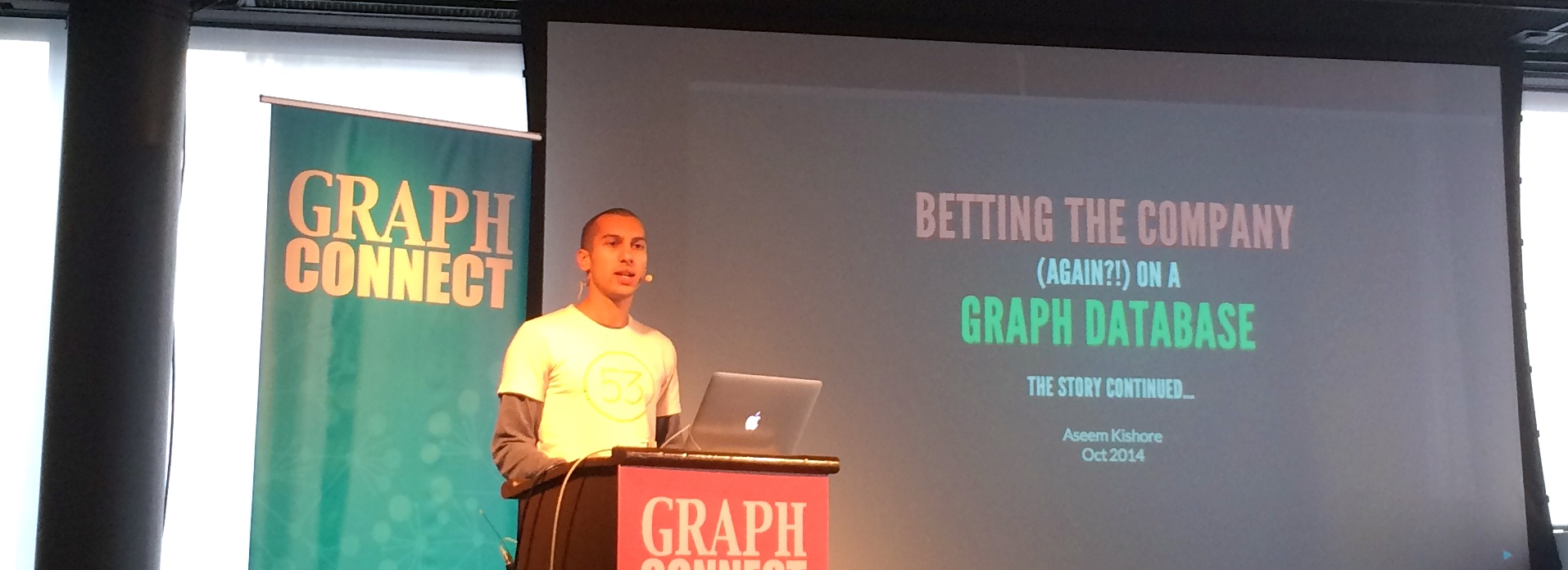
- Mix by 53
- Platform for collaborative creation
- Relationship direction choice
- Point to the thing that the other depends on
- Use linked list in-graph for better performance
- Streams - profile stream
- Pagination
- Must deal with changing data
- Instead of skip, use cursor time and filter based on that
- Home stream (with recommendations)
- Deduplication
- WHERE NOT is expensive
- Use PROFILE to profile query plan
- Logarithmic threshold (???)
Neo4j At Scale Using Enterprise Integration Patterns#
Brad Nussbaum (CTO, MediaHound)#
Slides: http://www.slideshare.net/neo4j/media-hound-graphconnectfinal
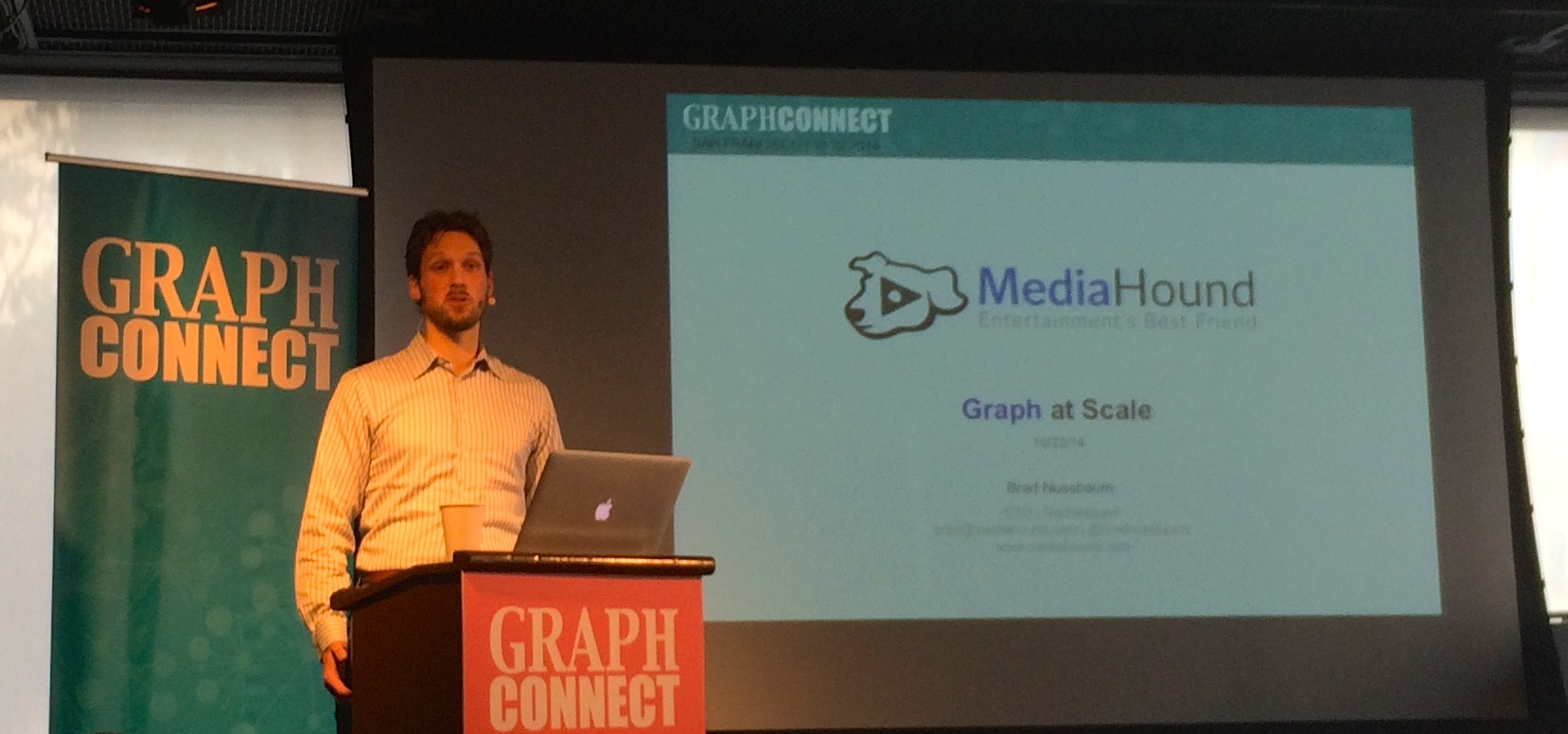
- Mediahound is building the entertainment graph
- Collaborative filtering for recommendations
- Graph influencers
- Requirement: sustained user write load and handle batch updates
- Use transactional cypher endpoint
- Best for batch updates
- Writing a single relationship is 33 byte write to disk
- As of 2.2 Neo4j will batch writes on server
Enterprise integration patterns#
- Splitters - break down larger messages
- Aggregators - batching
- Throttling - limit concurrent writes. Use Neo4j status codes
- Push factor - how many replications must be written to for a successful return
- Cypher is the standard
- Check driver for transaction support
- "USING INDEX" hint
- Recommendation processing with AWS spot instances
- Server extensions
- Cache abstraction with Google Guava. Large in-memory caching.
AWS Sport Instance Grid Processing#
- Spot instances are bid-based and can be killed at any time if out bid
- Used for concurrent job processing
- Use Cypher statements that are not dependent
- Compound statements for Node/Relationship creation for the subgraph
ESB#
- 400 to 2000 updates per transaction is optimal
- Insert nodes -> single lock
- Insert relationships -> 2 node lock, so do node insertions first
Applying The GraphAware Framework#
Michal Bachman (Director, GraphAware)#
Slides: http://www.slideshare.net/neo4j/graphconnect-2014-sf
@graph_aware
@bachmanm
- GraphAware combines common patterns into a framework
- Open sourced
Advanced Use Cases#
- Custom APIs
- Transaction driven behavior
- Async / background processing
Custom APIs#
- access to Java API for improved performance
- Locking - selective locking
- use-case too complex for Cypher
- Custom logic
- limit to read only
- custom I/O format
- code to data distance
- GraphAware
- Spring MVC
- testing with GraphUnit
- Demo
- Time hierarchy with GA TimeTree
/timetree/now?resolution=second- creates hierarchy/timetree/range...- query based on range
Transaction Driven Behavior#
- ACID
- Integration with other systems
- in-graph indexing
- additional modifications per transaction
- schema enforcement
- Demo
- Track changes in graph
- Assign UUIDs
Async / Background computation#
- Crawlers
- Neo4j is very good at OLTP
- Graph algorithms can be expensive in real-time, but many can be approximated
- Execute computation during quiet periods
- Adapts as usage changes
- PageRank (random walk, incremental counter)
- Recommendation
- Similarities
- Centralities
- Statistics
- Demo
- Random graph generation
- run NodeRank in background
- Recommendation system is WIP for GraphAware
Keynote: Impossible Is Nothing With Graphs#
Jim Webber (Chief Scientist, Neo Technology)#
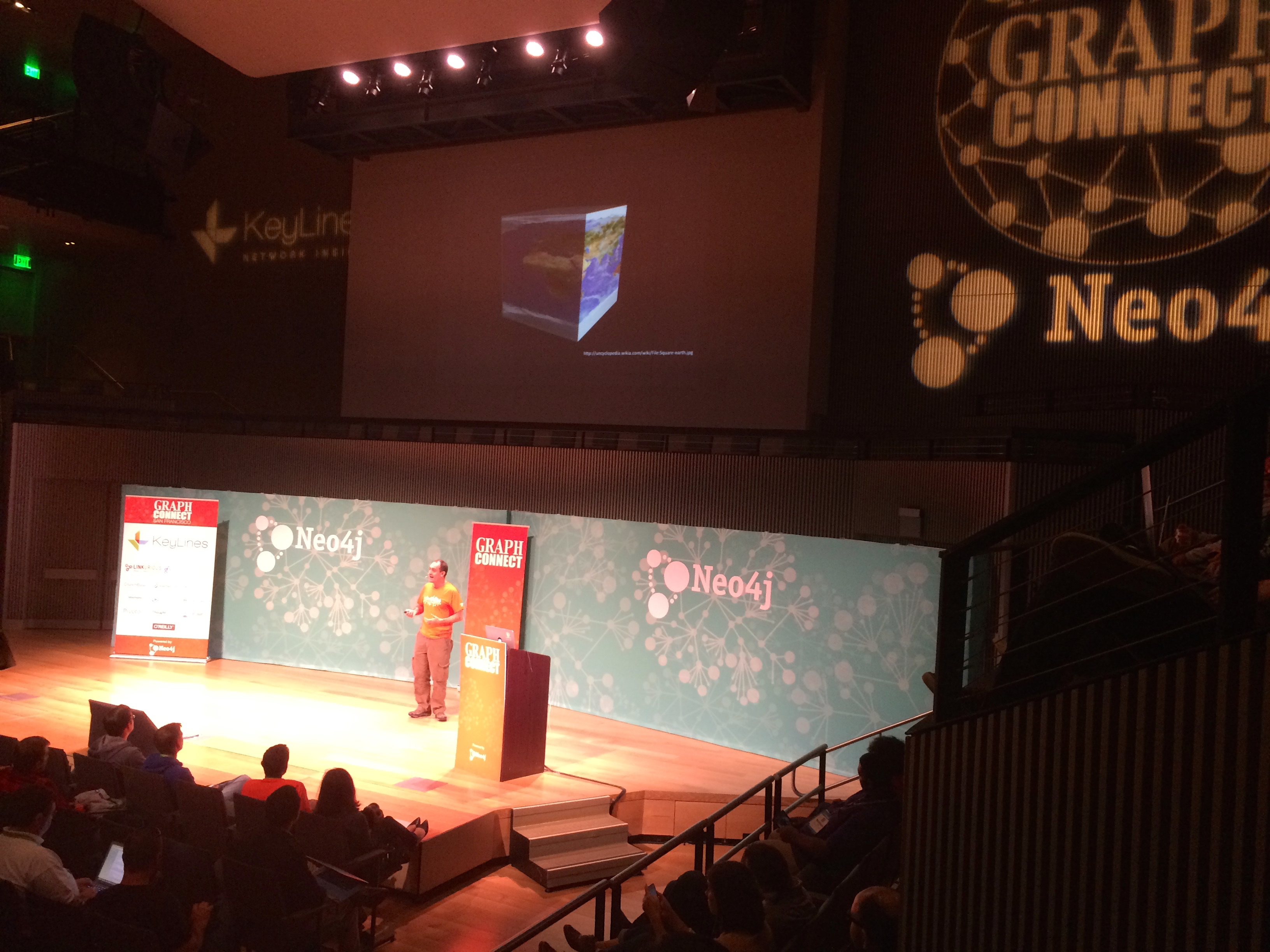
- Graph databases revolutionize data
- Reliabiliity, availability, eventual consistency
- As Neo4j is becoming more aggressive, how is this impacting the technology?
History of data#
-
70s
- databases reflected squareness of data
-
80s
Databases designed for boring payroll processing, not your geospatial, social, mating mashup.
-
90s
- Data got big
- The Web! Graph data at scale, but nobody realized it because they were too busy dealing with app servers and ORMs
- "The Vietnam decade of computer science"
-
00s
- Large web properties building their own databases
- Scale - NoSQL to the rescue!
- Most NoSQL DBs deal with aggregate (unconnected) data
- MapReduce to find connections
- With graph database connections are first class citizens
- Richer model with connected data
Graph Database Use-Cases#
-
Telenor - manage hierarchy of customers
-
Beamly - second screen startup. Metadata about TV
-
eBay Now - quick routing
- Before Neo4j, had queries longer than their shortest deliveries
-
Accenture - saved Christmas with improvements on parcel delivery routing
-
CrunchBase - the Business Graph
-
Neo4j is still a small (scrappy) startup
Reliability vs Availability#
- Lee-Anderson - Fault Tolerance
- Dependability
- Tradeoff between availability (uptime) and reliability (probability to produce correct output)
- Integrity
- Safety
- Confidentiality
- Should the system be available or reliable?
- depends
- Aggregate database -> agree on a single value
- Graph database -> 2 nodes in relationship both have to agree
- For Graphs: reliability over availability
What's Next?#
- Bigger data (trillions of nodes)
- Smarter Cypher, learn from previous queries
- More throughput
- How is this possible?
- Native graph all the way down
- Optimize everywhere
- Native graph all the way down
Stay Updated
Get notified about new posts and videos